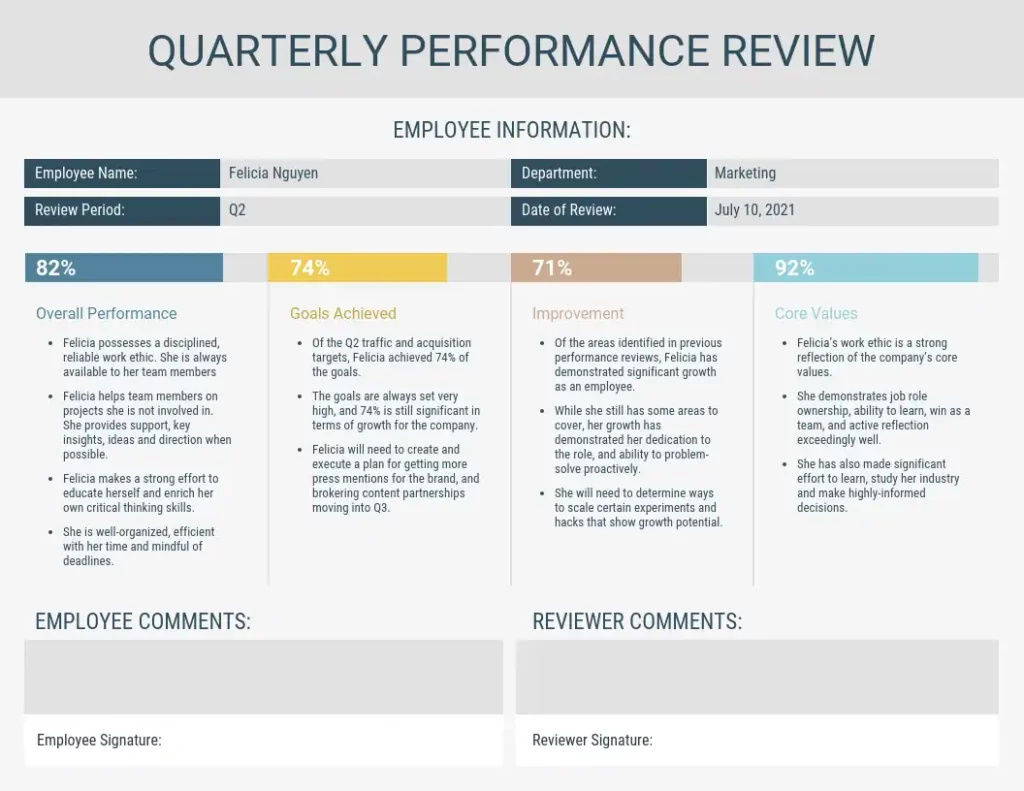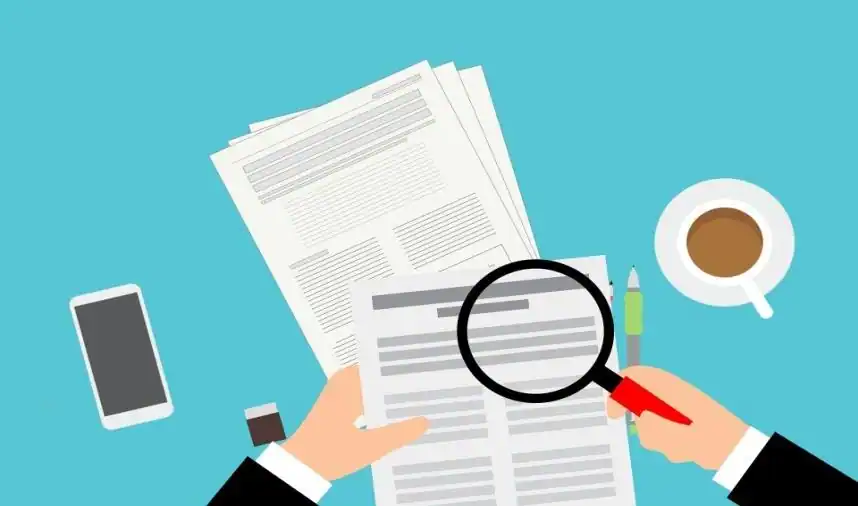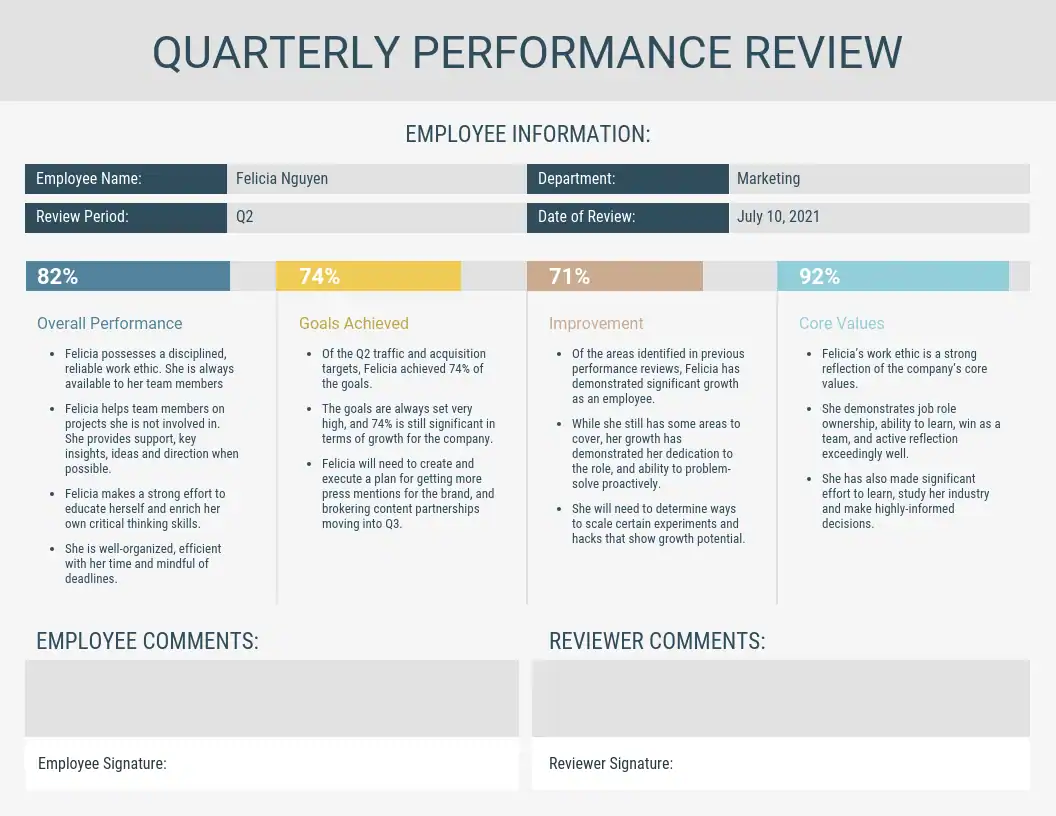Holding employee performance reviews is an integral part of running a business. However, if you do not have a timeline for preparing for these reviews, they can be very chaotic and unproductive. By making a timeline and following a few simple tips, you can make the process easier on yourself and ensure that your employees receive the best review possible. This article will serve as a guide to help you get started.
Employee Performance Review
A performance review is essential for assessing an employee’s progress and development. By setting aside time to review an employee’s performance regularly, you can identify areas where they may need improvement and provide feedback that can help them grow in their role. If you’re looking for performance review examples, you can check out Venngage today and create an account. There are a variety of performance review templates to choose from, which you can easily customize to fit your needs.
Steps For Preparing An Employee Performance Review Timeline
One of the essential tasks in human resources is preparing employee performance reviews. Trying to finish everything on time while ensuring all the necessary details are included can be challenging. But careful planning can make the process a lot less stressful. Here are some steps you can take to get started on the employee performance review timeline:

- Decide when to hold the performance review.
A performance review is essential for assessing an employee’s progress and development. But before you can conduct a review, you need to decide when to hold it. Most performance reviews are conducted on an annual basis. However, depending on your business needs, you may want to have them more or less often.
If you’re unsure how often to conduct performance reviews, it’s a good idea to speak with your HR team or consult an expert. They will be able to provide guidance on how often performance reviews should be conducted and help you develop a timeline that works for your business.
- Determine what format the performance review will take.
Once you’ve decided when to hold the performance review, you need to determine what format it will take. Will it be a written report? A face-to-face meeting? Or a combination of both?
There are pros and cons to each approach. A written report can be a great way to document an employee’s progress over time. However, writing down all the necessary details can also be challenging. A face-to-face meeting, however, allows for a more open dialogue between you and the employee. But it’s important to remember that not all employees are comfortable speaking up in a meeting setting.
The best approach is often a combination of both written and verbal communication. This way, you can ensure that all the relevant information is captured and that the employee has an opportunity to provide feedback.
- Create a timeline for the performance review process.
Once you’ve decided on the performance review format, it’s time to create a timeline for the process. This timeline should include all the steps involved and the correct chronology in conducting a performance review from start to finish.
The timeline will vary depending on the performance review format you’ve chosen. For example, if you’re conducting a face-to-face meeting, you’ll need to schedule time for both the conference and any follow-up communications. If you’re doing a written report, you’ll need to allow time to collect data, write the report, and give the employee time to provide feedback.
The timeline should also include deadlines for each step in the process. This step will help ensure that the performance review is conducted on time and that all the relevant information is captured.
- Customize the timeline to fit your needs.
Once you’ve created a timeline, it’s essential to customize it to fit your business needs. Depending on the performance review format you’ve chosen, this may involve adding or removing steps. For example, if you’re conducting a face-to-face meeting, you may want to add a step for preparing an agenda. Or, if you’re doing a written report, you may want to add a step for reviewing the data collected. You can also use a graphical timeline to display the progress or to map out the steps in a process.
It’s also important to note that the timeline will need to be updated on an ongoing basis because the performance review process can change over time, depending on the needs of your business. By keeping the timeline up-to-date, you can ensure that the performance review process is conducted effectively and efficiently.
When creating your timeline, keep your company goals in mind. Doing this will help you prioritize the steps involved and ensure that the performance review process is aligned with your company’s objectives.

- Get input from others involved in the performance review.
Once you’ve created a timeline, getting input from others involved in the performance review is essential. These people include the employee’s manager, direct reports, and other relevant stakeholders. Their input will help ensure that the timeline is realistic and that all the necessary steps are included. It’s also an excellent opportunity to get feedback on the performance review format and ensure everyone is on the same page.
- Finalize the timeline and performance review process.
After you’ve collected input from all the relevant stakeholders, it’s time to finalize the timeline and performance review process, which includes creating necessary documentation, such as a performance review template, and ensuring that everyone understands their role in the process. Once everything is finalized, you can start conducting performance reviews regularly.
A performance review is valuable for assessing an employee’s progress and development. By creating a timeline, you can ensure that the process runs smoothly and that all the necessary steps are included. Remember to give yourself plenty of time to prepare and collect all the required information and customize the timeline to fit your company’s needs and goals. With some planning, you can make the process much easier and more efficient.
